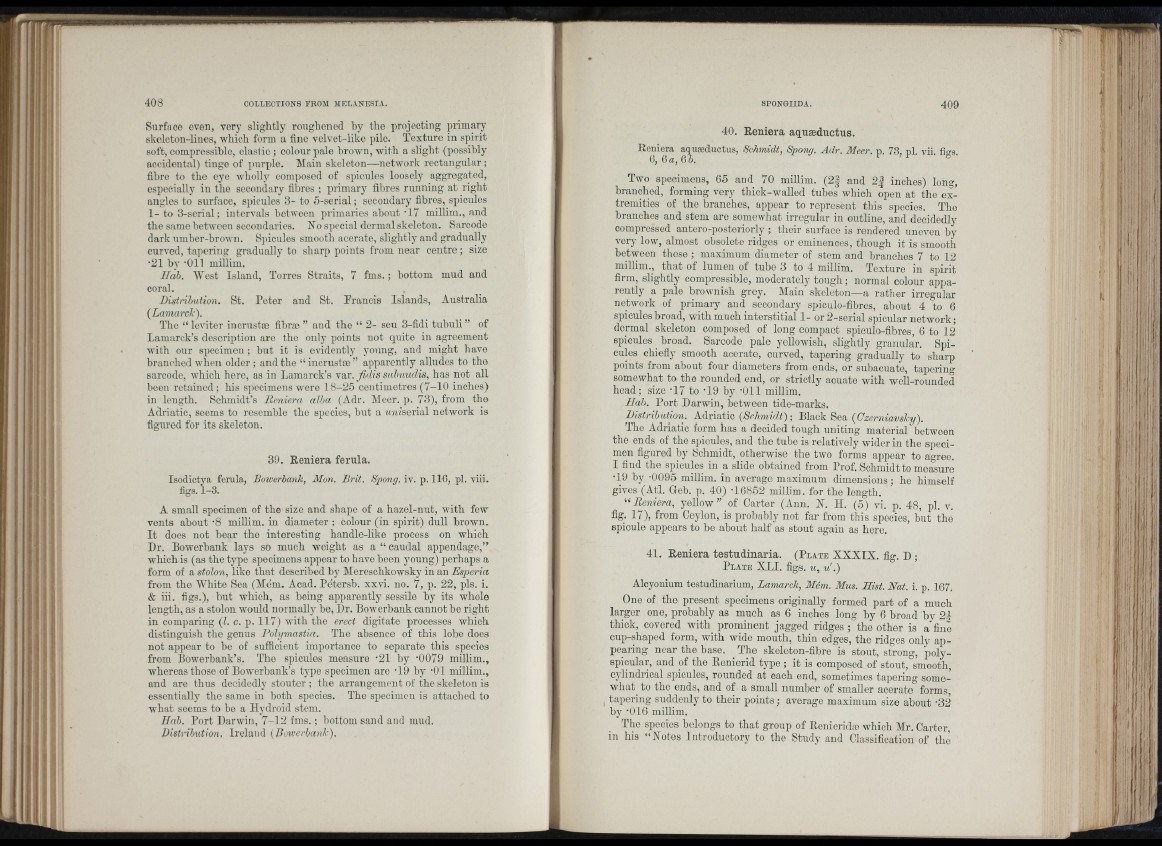
i "
Surface even, very slightly roughened by tho projecting primary
skeleton-lines, which form a fine velvet-liko pile. Texture in spirit
soft, compressible, clastic ; colour pale brown, with a slight (possibly
accidental) tinge of purple. Main skeleton—network rectangular ;
fibre to the eye wholly composed of spicules loosely aggregated,
especially iu the secondary fibres ; primary fibres running at right
angles to surface, spicules 3- to 5 -se ria l; secondary fibres, spicules
1- to 3-serial; intervals between primaries about ‘17 millim., and
the same between secondaries. No special dermal skeleton. Sarcode
dark nmher-brown. Sjucnles smooth acerate, slightly and gradually
curved, tapering gradually to sharp points from near c en tre ; size
•21 by "Oil miilim.
Jlab. West Island, Torres Straits, 7 fm s.; bottom mud aud
coral.
Distrihution. St. Peter aud St. Fraucis Islauds, Australia
(Lamarck).
Tho “ leviter incrusta? fihra; ” and the “ 2- sen 3-fidi tu b u li” of
Lamarck’s description aro tho only points uot quite in agreement
with our specimen ; but it is evidently young, and might have
branched when older; and the “ incrnstse” apparently alludes to the
sarcode, which here, as in Lamarck’s Yav. Jidis suhnudis, has not all
been retained ; his specimens were 18-25 centimetres (7-10 inches)
in length. Schmidt’s licniera alha (Adr. Meer. p. 73), from the
Adriatic, seems to resemble the species, bnt a MJiZserial network is
figured for its skeletou.
39. Eeniera ferula.
Isodictya ferula, Boiverhank, Mon. Brit. Sjiong. iv. p.
figs. 1-3.
116, pi. viii.
A small specimen of the size and shape of a hazel-nut, with few
veuts about -8 millim. iu diameter ; colour (iu spirit) dull brown.
I t does not hear the interesting handle-like process on which
Dr. Bowerbank lays so much weight as a “ caudal appendage,”
which is (as the type specimens appear to have been young) perhaps a
form of a stolon, like that described by Mereschkowsky in an Esperia
from the White Sea (Mem. Acad. Petersb. xxvi. no. 7, p. 22, pis. i.
& iii. figs.), hut which, as being apparently sessile by its whole
length, as a stolon would normally be, Dr. Bowerhank cannot be right
in comparing (I. c. p. 117) with the erect digitate processes which
distinguish the genus Folymastia. The absence of this lobe does
not appear to he of sufficient importance to separate this species
from Bowerhank’s. The spicules measure ^21 by •0079 millim.,
whereas those of Bowerbank’s type specimen are '19 by '01 millim.,
and are thus decidedly stouter ; the arrangement of the skeleton is
essentially the same in both species. The specimen is attached to
what seems to he a Hydroid stem.
Hah. Port Darwin, 7-12 fm s.; bottom sand and mud.
Distrihution. Ireland (Boiverbank).
40. Reniera aqnæductus.
Remera aqnæductus, Schmidt, Spong. Adr. Meer. p. 73, pi. vii. fio-s.
6, 6 a, 6 6. “
Two specimens, 65 and 70 millim. ( 2 | and 2 | inches) long,
branched, forming very thick-walled tubes which open at the extremities
of the branches, appear to represent this species. The
branches and stem are somewhat irregular in outline, and decidedly
compressed antcro-posteriorly ; their surface is rendered uneven by
very low, almost obsolete ridges or eminences, though it is smooth
between these ; maximum diameter of stem and branches 7 to 12
millim., th a t of lumen of tube 3 to 4 millim. Texture in spirit
firm, slightly compressible, moderately tough ; normal colour apparently
a pale brownish grey. Main skeleton—a rather irregular
network of primary aud secondary spiculo-fibres, about 4 to 6
spicules broad, with much interstitial 1- or 2-serial spicular network;
dermal skeleton composed of long compact spiculo-fibres, 6 to 12
spicules broad. Sarcode pale yellowish, slightly granular. Spicules
chiefly smooth acerate, curved, tapering gradually to sharp
points from about four diameters from ends, or subacuate, tapering
somewhat to the rounded end, or strictly acuate with well-rounded
head; size -17 to -19 by -Oil millim.
Hah. Port Darwin, between tide-marks.
Distrihution. Adriatic (Schmidt); Black Sea (Czerniavsky).
The Adriatic form has a decided tough uniting material between
the ends of the spicules, aud the tube is relatively wider in the specimen
figured by Schmidt, otherwise the two forms appear to agree.
I find the spicules in a slide obtained from Prof. Schmidt to measure
•19 by -0095 millim. in average maximum dimensions ; he himself
gives (Atl. Geb. p. 40) -16852 millim. for the length.
“ Reniera, yellow” of Carter (Ann. N. H. (5) vi. p. 48, pi. v.
fig. 17), from Ceylon, is probably not far from this species, hut thè
spicule appears to be about half as stout again as here.
41. Reniera testudinaria. ( P l a t e XXXIX. fig. D ;
P l a t e XLI. figs. u, ü .)
Alcyonium testudinarium, Lamarck, Além. Mus. Hist. Nat. i. p. 167.
One of the present specimens originally formed part of a much
larger one, probably as much as 6 inches long by 6 broad by 2 |
thick, covered with prominent jagged ridges ; the other is a fine
cup-shaped form, with wide mouth, thin edges, the ridges only appearing
near the base. The skeleton-fibre is stout, strong, poly-
spicular, and of the Renierid type ; it is composed of stout, smooth,
cylindrical spicules, rounded at each end, sometimes tapering somewhat
to the ends, and of . a small number of smaUer acerate forms,
tapering suddenly to their points ; average maximum size about -32
by ‘016 millim.
The species belongs to th at group of Penieridæ which Mr. Carter,
in his “ Notes Introductory to the Study and Classification of thè
if
' 'i.